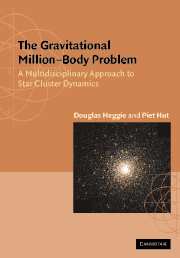Book contents
- Frontmatter
- Contents
- Preface
- PART I INTRODUCTIONS
- PART II THE CONTINUUM LIMIT: N → ∞
- PART III MEAN FIELD DYNAMICS: N = 106
- PART IV MICROPHYSICS: N = 2
- PART V GRAVOTHERMODYNAMICS: N = 106
- PART VI GRAVITATIONAL SCATTERING: N = 3
- PART VII PRIMORDIAL BINARIES: N = 4
- PART VIII POST-COLLAPSE EVOLUTION: N = 106
- PART IX STAR CLUSTER ECOLOGY
- Appendix A A Simple N-Body Integrator
- Appendix B Hints to Solution of Problems
- References
- Index
Preface
Published online by Cambridge University Press: 05 June 2012
- Frontmatter
- Contents
- Preface
- PART I INTRODUCTIONS
- PART II THE CONTINUUM LIMIT: N → ∞
- PART III MEAN FIELD DYNAMICS: N = 106
- PART IV MICROPHYSICS: N = 2
- PART V GRAVOTHERMODYNAMICS: N = 106
- PART VI GRAVITATIONAL SCATTERING: N = 3
- PART VII PRIMORDIAL BINARIES: N = 4
- PART VIII POST-COLLAPSE EVOLUTION: N = 106
- PART IX STAR CLUSTER ECOLOGY
- Appendix A A Simple N-Body Integrator
- Appendix B Hints to Solution of Problems
- References
- Index
Summary
Since this book is aimed at a broad audience within the physical sciences, we expect most of our readers not to be experts in either astrophysics or mathematics. For those readers, the title of this book may seem puzzling at least. Why should they be interested in the gravitational attraction between bodies? What is so special about a million-body problem, rather than a billion or a trillion bodies? What kind of bodies do we have in mind? And finally, what is the problem with this whole topic?
In physics, many complex systems can be modelled as an aggregate of a large number of relatively simple entities with relatively simple interactions between them. It is one of the most fascinating aspects of physics that an enormous richness can be found in the collective phenomena that emerge out of the interplay of the much simpler building blocks. Smoke rings and turbulence in air, for example, are complex manifestations of a system of air molecules with relatively simple interactions, strongly repulsive at small scales and weakly attractive at larger scales. From the spectrum of avalanches in sand piles to the instabilities in plasmas of more than a million degrees in labs to study nuclear fusion, we deal with one or a few constituents with simple prescribed forces. What is special about gravitational interactions is the fact that gravity is the only force that is mutually attractive.
- Type
- Chapter
- Information
- The Gravitational Million–Body ProblemA Multidisciplinary Approach to Star Cluster Dynamics, pp. ix - xivPublisher: Cambridge University PressPrint publication year: 2003



